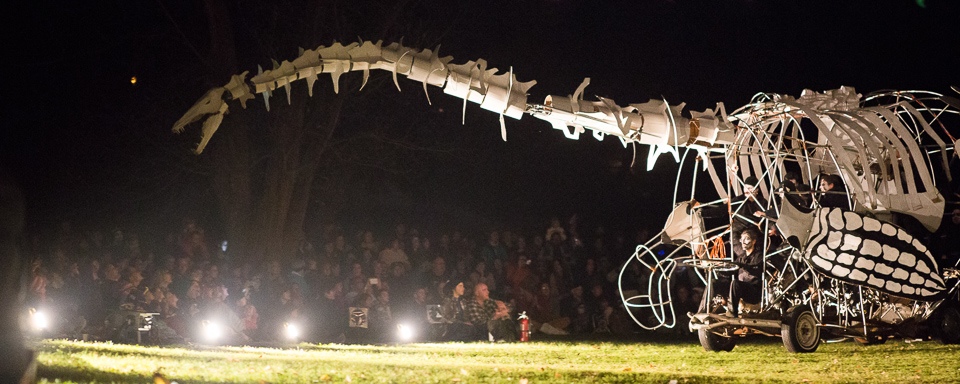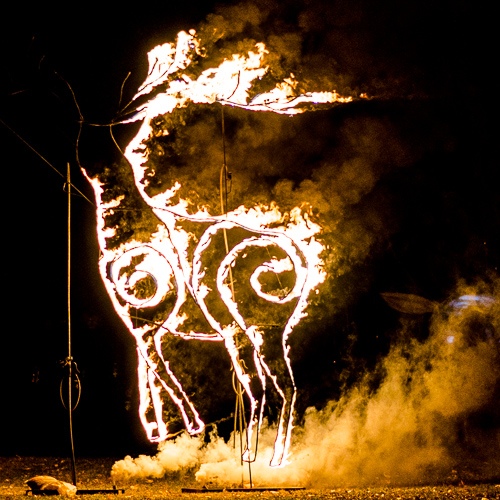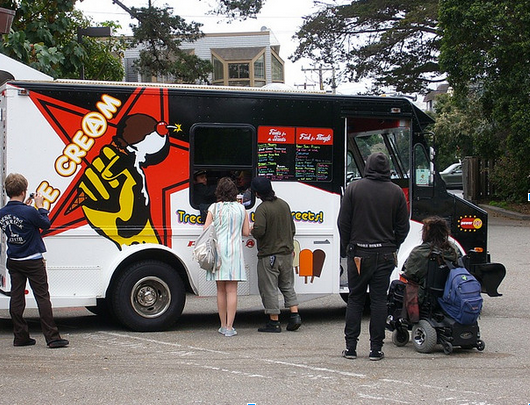Disasters Align
Sam Gould makes the case for a rangier sort of socially-engaged art, one that forgoes easy, artworld-friendly categories like "social practice" in favor of articulating a field of practice that embraces more disruptive, unabashedly irrational work and interaction.

One night this fall, surrounded by a few hundred others, I sat cross-legged in the dirt with my daughter, Esme, on my lap, watching a skeletal dinosaur and a ghostly scarecrow-looking guy, both about seven or eight feet in height, as they danced with one another. Many of you who live in the Twin Cities likely know what I was up to. A crowd just like ours had been gathering each night for the last week in October, down by the banks of the Mississippi River for an annual puppet show celebrating death and remembrance. It’s called BareBones and, for me (and many, many others), it has become a fall ritual to attend, a seasonal habit as ritualistic for our family as the loose themes engaged by the company of performers. In fact, each year, each performance, it seems the audience and the troupe conjoin. Attendance isn’t a passive thing; it’s an act of complicity, solidarity. Maybe even agency.
I didn’t know about BareBones prior to moving to Minneapolis in 2010. That fall, my father-in-law, Richard Baldwin, fairly unexpectedly and horrifically died after a long summer of illness and attempted recuperation. The following year, I was invited to the performance by his brother, Mark. I went with one of my daughters and my son, Louis. I had no idea what to expect. At the time, our three kids were pretty young and wily, and we lived in a very small carriage house — all five of us. Any opportunity to move about, even in the cold of a late October Minnesota evening, seemed worth the effort it took to wrangle them.
As it happened, we attended BareBones a little over a year to the day after Rick’s death. I left the performance that night feeling, in some inexplicable way, that the grief and confusion of the previous year had been somehow transformed, that we were allowed to, if not quite move on, become something new, something regenerated. That night, his death and all that surrounded it was remade in my mind as something much larger and far less singular.
Since then, I’ve gone each year to BareBones. The show’s different every time but also pretty much the same. There’s really not much of a plot, but the throngs of people walking down the hill towards the river to see the show don’t mind. The newly minted fall darkness, the lights, sounds, costumes, and ritual all amount to something much more than narrative. As the documentarian Laura Poitras remarked not long ago in a New Yorker profile on the making of Citizen Four: “Plot is so relentless.” She continued, “It also can be simplifying. It can provide resolution where there should be none. It can provide false catharsis.”

Photo courtesy of BareBones
BareBones taps right in to this millennia-old confusion and meaninglessness — sure, let’s call it plotlessness — that we as a global culture unconsciously crave. And the company does it so well that, each year, when I leave, I feel renewed and fortified for the long, hard winter ahead of us.
While I like a good story as much as the next person, I recognize it as just that: a story, something made up. Confusion, more often, is what I’m after, because I know it’s within the tumult of undefined space that ideas, desires, and ethics begin to form. Truth, like plot, only lasts for short moments of collective agreement. We soon move on, forming new truths, new realities. I’m interested in a space of confusion that involves more subjectivities than my own, a space of confusion populated by others. Because it’s there — the space where we are asked to question, together, what’s in front of us — that a public forms around shared desire, around ethics. And those are qualities far more important than the false binaries of truth and falsehood. The irrational is a place we can inhabit unencumbered by the burdens of “truth.” This shared space of the irrational is where we might collectively begin to form shared meaning, however inarticulate. And it’s a space that is, thankfully, always changing.
A few nights ago, after leaving a movie with my partner, Laura, I started talking about how much I need this sort of irrationality in my life. I need this state of being which, for sake of argument, we can call the production of confusion. I began to explain to her how I felt, and why I’d argue that this so-called irrationality is rich with meaning, chock-full of social and political import. Later that night, while reading Maggie Nelson’s Women, the New York School, and Other True Abstractions, I ran across a quote by the poet Frank O’Hara that spoke to what I was after in much the same manner:
“It may be that poetry makes life’s nebulous events tangible to me and restores their detail; or conversely that poetry brings forth the intangible quality of incidents which are all too concrete and circumstantial. Or each on specific occasions, or both all the time.”
There is a certain kind of cultural practice — sanctioned, ad-hoc, or somewhere in between — that seems to me to speak to these intangible moments of the irrational within our everyday. And this practice speaks to it in a way that allows us a moment of repose to reflect on where we are placing ourselves upon our collective landscape of experience. Far from didactic, though not devoid of politics, these actions ask us to consider the distance between our whole bodies and those of others.
I came across this graffiti while driving the other day:
.jpg)
I can’t remember why, but my mood prior to coming across it was low. But the outsized juvenilia of it, written huge along the wall of a St. Paul community center on Lexington Avenue, did more than elicit a chuckle. I felt a real, palpable elation. Seeing it, a crack opened up in my day to reveal how, simultaneously, there’s so much to be angry about, so much to rail against, and yet how it’s all just a joke, too, a power-play. The graffiti seemed to me at once a big fuck you and an elaborate question mark.
Walking back to the car with my kids after taking the photo above, I spotted an empty bottle of Carlo Rossi champagne and an empty whip-it, CO2 canister nearby in the field. God bless that punk. Who knows to what extent she altered other people’s consciousnesses, their chosen actions upon encountering her own. For me, she opened up in an otherwise low moment vistas of humor, rebellion, history, and the wealth of tools available to every individual to alter our perception of the possible.
My observation might seem to some as short-sighted; such folks would probably view the graffiti in much the same way. And, in some ways, they’re right. “Lick My Balls” — no matter how well you control your hand to create a beautiful tag — written nine-feet tall on a highly visible community center, in and of itself, is nothing much. Yes, it’s stupid. But it doesn’t exist in a vacuum. That mark — taken in the context of others like it made through the ages, from cave paintings to protest signs — asks us to look closer, to consider both its volition and our own. It asks, “How much are you giving in? Giving up?” Contrary to a more authoritarian argument — a didactic pose or command or moral judgment — ambiguity acted upon knowingly is a social act. It’s an act that suggests we join in the revelry, even if we don’t know why as of yet, because we’re there, in it, together.
.jpg)
FLOOD, by the Chicago arts group, HaHa
The artist behind this tag is part of a broad tradition of cultural (re)production, one which has existed for ages. It’s a field of practice that also includes hydroponic growing centers created to provide organic medicine for HIV/AIDS patients (FLOOD, a work by the Chicago arts group, HaHa). In its ranks are an abstract noise band formed and disbanded during wartime which — through their choices of venues, pre-show “diatribes,” and their considered relationship and engagement between “audience” and “performer”– was nothing if not a political provocation (Yellow Swans). It’s a field of practice that was home to an armored ice cream truck which roamed the country serving both tasty treats and radical literature to unsuspecting adults and children.
It’s a type of cultural work which has existed for ages that asks us to question together. Engaging this sort of work is itself a political act steeped in subjectivity and the transformative power of the irrational. However seemingly at odds they are in the details, all of the above projects are united in their resolve to let go of pre-conceived responsibilities, the need to release oneself from the dominant culture of response to questions which do not speak to real, urgent, and complex needs as a form of shared empowerment.

The Tactical Magic Ice Cream Unit
For the last decade or so, the “art world” has seen the rise of so-called social practice. Regrettably, the designation has become a sort of catch-all aesthetic corral for any artwork that doesn’t have a recognizable material commodity attached to it, or which asks people to come together for something or other. Not all of this work is the same. And it should be obvious to all at this late stage in the game that bodies, even the seemingly empty space between bodies, can be as easily commoditized and turned into fluid objects as any painting, rug, trash can, or social networking apparatus. I’m not interested in work that does this sort of thing. I can watch Top Chef and The Real World for that fix.
But I’m also not here to argue that such work is not social practice or, alternately, that this work is bad social practice. What I am here to argue (and then, I hope, quickly drop, so as to discuss more energetic and important things) is that “social practice” is, simply enough, itself a market construction. Use the terminology if you want, but as a self-contained field of cultural practice it doesn’t exist. The ways we link and find allegiance between such artworks is going to need to be more rigorous and far more expansive than any current catch-all category allows, especially if we see this work as political in nature. To paraphrase Joan Mitchell’s writing on abstraction, social practice is not a style. And inasmuch, an adequate accounting of the field is going to require us to allow the work of Sister Corrita, Mike Rakowitz’s Enemy Kitchen, Gran Fury, or David Hammons’ Bliz-aard Ball Sale to exist alongside far more complicated company. Your seven-year-old sister’s lemonade stand wherein you pay by sharing your recollections of childhood dreams rightfully exists on a continuum of more readily identifiable “artworks” and needs to be valued equally if we see these acts as inherently subjective (social) and not objective (commodity). We need to value these kinds of works on a broad continuum as much for their tenuous similarities as their vigorous contradictions.
I make this argument not for the sake of mere inclusivity. That’s nice and all, but it doesn’t get us anywhere in particular. This type of intangible cultural work, produced both inside and outside of aesthetic histories and institutions of legitimation, holds a common if not mutually misunderstood desire: that of transparency and autonomy.
Over a series of conversations published here in future months — with artists, musicians, activists, educators, lemonade stand proprietresses — I hope to begin to articulate and illustrate more precisely this type of irrational social production, because I think it is vital. This work is not just nice, or fun, or even exciting. Such practice might be the last open-ended emotional space available to us at a time that is otherwise overly cautious, controlled, and even contemptuous of art with reach and utopian vision. This is work that affords us space to breathe, to rebel — not as an act of self-othering but by way of invitation. It’s really difficult not to be normal today, but not being normal is the only thing keeping us from going off the edge.
Furthermore, I want to talk about who gets to be irrational, and how through the act of so-called irrationality we might find space for new norms. Irrationality is as much a form of agitation as it is a form of escape. Sometimes (quite often, actually) it is both simultaneously. In its present state, when recognized solely through the art world and the lens of commodification, “social practice,” as one form of irrationality, needs to be viewed for what it is: a predominantly middle-class white form of cultural production. When viewing irrational social action more broadly, outside the limited terrain presently allowed through the terminology of social practice and its place within the art world, that middle-class whiteness is not as dominant. Every race, every culture, has its histories of generative chaos. But, it must be pointed out, even when engaging irrationality more broadly, the consequences of such actions vary widely depending on race, gender, class, and more.
The recent groundswell of #BlackLivesMatter actions are, to some, viewed as completely irrational acts. To others they are a lifeline. To others still, they’re a jumping-off point for further agitation against a culture of abuse. This divide is potent space, and it requires those with certain privileges to consider and discuss the implications of our irrationality and its possible blowback, for good and for ill, when acted out — as it always will be — upon a more richly hued and complex landscape of experience.
Toward the middle of this year’s BareBones, the performance slowly built into an assembly of dozens of little illuminated creatures that began to appear out of the darkness. The troupe, hidden in the October night, began to sing a simple, repetitive call and response: “The ocean is the beginning of the earth. All life comes from the sea.”
It appeals to me to replace, in this circumstance, “the ocean” with “the irrational.” For sake of argument — in terms of engagement, understanding the logic of how and why we would delve into something so messy, and how we could begin to contemplate the irrational as socially and politically necessary — this analogy fits. The irrational, like the ocean, is deep, dark, and at times dangerous. We know hardly anything about it, really. It’s also immensely fucking interesting. Our interactions vary. Some would nearly drown us. If we’re to stay afloat we need to consider the crafts we’re utilizing. And our jobs throughout? The everlasting maintenance of these ships we’re sailing together on common waters.
Born in New York City in the mid-1970s, Sam Gould is the co-founder and editor of Red76, a publication that materialized in Portland, Oregon in the early 2000s. Instrumentalizing ideas around publication as a social force, Red76 works towards the formation of publics through the implementation of ad-hoc educational structures and discursive gatherings. While these actions are often situated in what is called “public space,”– such as street corners, laundromats, taverns, and the like — the pedagogy of their construction is meant to call into question the relationships, codes, and hierarchies embedded within these landscapes from one incident of publication to the next. Along with a desire to illustrate the shared experiences of an accumulated public, Red76 works to ask: What is a Public? and What is it Good For? Gould has taught within the graduate department for Social Practice at the California College of the Arts and the School of the Museum of Fine Arts, Boston. He has written, as well as lectured extensively within the United States and abroad, on issues of sociality, education, and encountering the political within daily life.